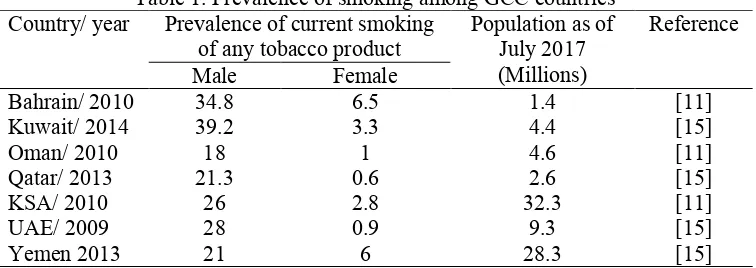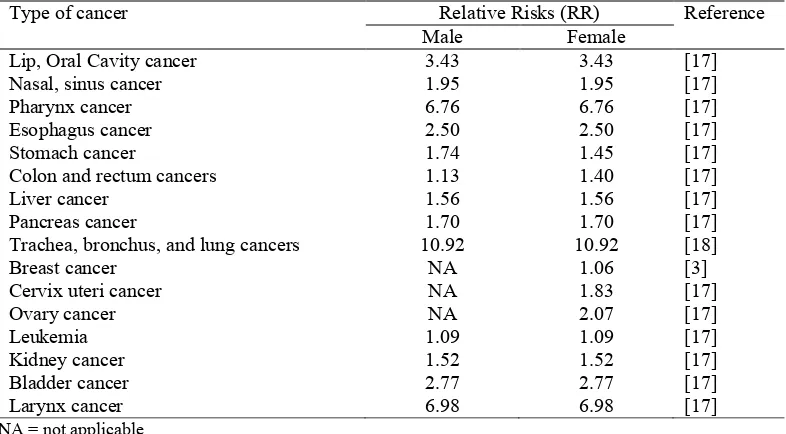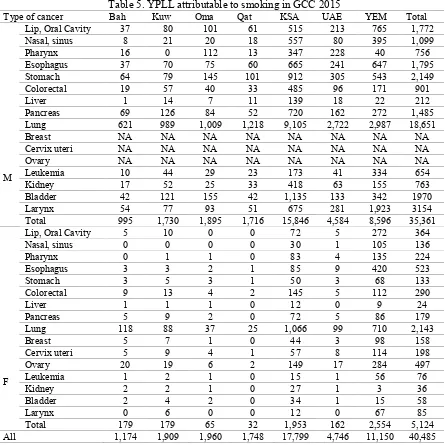7
ICASH-A02
BURDEN OF CANCER ATTRIBUTABLE TO SMOKING IN GULF
COOPERATION COUNCIL (GCC) COUNTRIES, 2015
Mouaddh Abdulmalik, Montarat Thavorncharoensap*
Social, Economic, and Administrative Pharmacy Department, Faculty of Pharmacy, Mahidol University, Bangkok, Thailand
* Corresponding author’s email: montarat.tha@mahidol.ac.th
ABSTRACT
Background: Smoking is a major cause of premature mortality worldwide. Smoking is recognized as the leading preventable cause of cancer and mortality from cancer. This study aims at estimating the number of cancer mortality and years of potential life lost (YPLL) attributable to smoking in GCC countries in 2015.
Methods: Smoking prevalence was combined with Relative Risks (RRs) of cancer to obtain smoking attributable fractions (SAFs). Mortality data of people older than 15 years were derived from WHO deaths estimates while life expectation was obtained from WHO life tables 2015. Sixteen types of cancer were included in the analysis.
Results: Smoking is responsible for 2,141 cancer deaths among people aged 15 years and above in GCC countries (1,895 deaths among men, 246 deaths among women). This represents 15% of cancer deaths in GCC (26.43% in male, 3.5% in female). Additionally, cancer deaths attributable to smoking were responsible for 40,485 YPLL (35,361 years among men, 5,124 years among women).
Conclusion: Smoking causes a considerable burden in GCC countries in term of mortality and years of potential life lost. Effective smoking control initiatives and sustained efforts are needed to minimize cancer burden in the future.
Keywords: Cancer, GCC, Premature mortality, Smoking, YPLL
INTRODUCTION
Cancer is a major public health problem. Globally, cancer is recognized as the second leading cause of premature mortality [1]. Smoking is a well-established risk factor for many types of cancer [2]. Globally, smoking is estimated to cause 30% of cancer deaths in 2004 [3].
The Gulf Cooperation Council [GCC]’s health council consists of seven countries, Bahrain, Kuwait, Oman, Qatar, Saudi Arabia, United Arab Emirates, and Yemen [4]. The aggregated population of GCC is estimated to be 82 million people [5, 6]. Currently, cancer has become a major public health problem and extensively impacts healthcare system [7]. Now cancer ranks among top four leading causes of death in this region. During the period from 1998 to 2009, 119,288 newly diagnosed cancer cases among the population of GCC countries except Yemen [8]. Moreover, these numbers were expected to increase in GCC due to several limitations in healthcare facilities, and rapid socioeconomic shifts that have led to unfavorable changes in lifestyle like physical inactivity, non-adherence to healthy foods, and on top of that high smoking rates [9]. By 2020, the new cancer cases would be expected to double, which equals a growth rate of almost 3 times greater than the international rate [10].
8
re-emergence of water pipe smoking as a popular tobacco use method [12]. In GCC countries the average number of smoked cigarette is 23.4 cigarettes per smoker per day in 2102 greater than the global average of 18 cigarettes [13]. Unprecedentedly, in some GCC countries the smoking rate increased by nearly 500% since 1990 to 2012 [10]. Hence, the objective of this study is to estimate the number of cancer mortality and YPLL attributable to smoking in GCC countries in 2015.
METHODS
Smoking Attributable Fraction (SAF)
Smoking attributable fraction (SAF) is a highly useful tool to estimate the death ratio, which can be attributed by smoking. To estimate SAF, the following formula [14] will be used:
SAFi (%) = 100* [P (RRi-1)/1+P (RRi-1)]
Where P is the prevalence of smoking and RRi is the relative risk of smoking for each type of cancer (i) included in the analysis.
Prevalence of smoking
Prevalence of smoking is the percentage of smokers in a given population [14]. For each country, the prevalence of smoking among individuals aged 15 years or above was obtained from WHO global health observatory date repository [11], and WHO report on the global tobacco epidemic 2017 [15] as shown in table 1. The effect of smoking on cancer risk is understood to be the result of past exposure. The time between initiation of exposure to smoking and cancer diagnosis is known as the latency period and start 2 to 33 years of the beginning of exposure to smoking [16]. Owing to data availability, the prevalence of 2009 was used for UAE, 2010 for Bahrain, Oman, and KSA, 2013 for Qatar and Yemen, and 2014 for Kuwait.
Table 1. Prevalence of smoking among GCC countries Country/ year Prevalence of current smoking
of any tobacco product
Population as of July 2017 (Millions)
Reference
Male Female
Bahrain/ 2010 34.8 6.5 1.4 [11]
Kuwait/ 2014 39.2 3.3 4.4 [15]
Oman/ 2010 18 1 4.6 [11]
Qatar/ 2013 21.3 0.6 2.6 [15]
KSA/ 2010 26 2.8 32.3 [11]
UAE/ 2009 28 0.9 9.3 [15]
Yemen 2013 21 6 28.3 [15]
KSA= Kingdom of Saudi Arabia, UAE= United Arab Emirates
Relative Risk
9
Table 2. Relative risks for smoking-related cancers
Type of cancer Relative Risks (RR) Reference Male Female
Lip, Oral Cavity cancer 3.43 3.43 [17] Nasal, sinus cancer 1.95 1.95 [17] Pharynx cancer 6.76 6.76 [17] Esophagus cancer 2.50 2.50 [17] Stomach cancer 1.74 1.45 [17] Colon and rectum cancers 1.13 1.40 [17]
Liver cancer 1.56 1.56 [17]
Pancreas cancer 1.70 1.70 [17] Trachea, bronchus, and lung cancers 10.92 10.92 [18]
Breast cancer NA 1.06 [3]
Cervix uteri cancer NA 1.83 [17]
Ovary cancer NA 2.07 [17]
Leukemia 1.09 1.09 [17]
Kidney cancer 1.52 1.52 [17]
Bladder cancer 2.77 2.77 [17]
Larynx cancer 6.98 6.98 [17]
NA = not applicable
Estimation of smoking attributable deaths (SAD)
For each type of cancer (i), the number of premature mortality attributable to smoking in 2015 was estimated by multiplying the corresponding SAFi with the total number of death (aged 15 years or over) in 2015. The Number of deaths by age and gender for cancers in all GCC countries were derived from WHO estimated deaths, which published in March 2017, where the number of death by cause, gender, country, and age (15-29, 30-49, 50-59, 69-69, 70-79) were reported [19].
Estimation of years of potential life lost (YPLL)
YPLL is determined as the remaining years of life expectancy at the time of death. The remaining life expectancy at the time of death was determined using life-tables published by WHO for 2015 [20].
RESULTS
Based on our estimates of smoking prevalence rates and the RRs of included cancers, SAFs were calculated. The SAFs were substantially higher for males than females, resulting from higher prevalence of smoking among males. Table 3 shows the SAFi for each cancer type in all GCC countries.
Table 3. Smoking Attributable Fractions (SAFi)
Cancer type SAF %
Bah Kuw Oma Qat KSA UAE Yem M F M F M F M F M F M F M F
10
M= male, F= female, Bah= Bahrain, Kuw= Kuwait, Oma= Oman, Qat= Qatar, KSA= Kingdom of Saudi Arabia, UAE= United Arab Emirates, Yem= Yemen. NA = not applicable
Table 4. Number of cancer mortality attributable to smoking, 2015 Cancer site Cancer mortality attributable to smoking
Bah Kuw Oma Qat KSA UAE Yem Total
M= male, F= female, Bah= Bahrain, Kuw= Kuwait, Oma= Oman, Qat= Qatar, KSA= Kingdom of Saudi Arabia, UAE= United Arab Emirates, Yem= Yemen. Roundup in calculations, NA = not applicable
Table 4 shows the number of cancer deaths attributable to smoking in GCC countries by gender. It was estimated that in 2015, there were 2,141cancer deaths attributable to smoking in GCC. Of this 1,895 deaths 88.5% occurred among men and 246 deaths 11.5% among women. The total number of cancer death attributable to smoking among men were 8 times higher than those of women. The number of premature mortality was the highest in Saudi Arabia, followed by Yemen. Lung cancer represents 53% of all premature mortality from cancer attributable to smoking. In both gender, 15% of cancer deaths in GCC was attributable to smoking (26.4% in male and 3.4% in female) in 2015.
11
Table 5. YPLL attributable to smoking in GCC 2015
Type of cancer Bah Kuw Oma Qat KSA UAE YEM Total
M
Lip, Oral Cavity 37 80 101 61 515 213 765 1,772 Nasal, sinus 8 21 20 18 557 80 395 1,099 Pharynx 16 0 112 13 347 228 40 756 Esophagus 37 70 75 60 665 241 647 1,795 Stomach 64 79 145 101 912 305 543 2,149 Colorectal 19 57 40 33 485 96 171 901 Liver 1 14 7 11 139 18 22 212 Pancreas 69 126 84 52 720 162 272 1,485 Lung 621 989 1,009 1,218 9,105 2,722 2,987 18,651 Breast NA NA NA NA NA NA NA NA Cervix uteri NA NA NA NA NA NA NA NA Ovary NA NA NA NA NA NA NA NA Leukemia 10 44 29 23 173 41 334 654 Kidney 17 52 25 33 418 63 155 763 Bladder 42 121 155 42 1,135 133 342 1970 Larynx 54 77 93 51 675 281 1,923 3154 Total 995 1,730 1,895 1,716 15,846 4,584 8,596 35,361
F
Lip, Oral Cavity 5 10 0 0 72 5 272 364 Nasal, sinus 0 0 0 0 30 1 105 136
Pharynx 0 1 1 0 83 4 135 224
Esophagus 3 3 2 1 85 9 420 523
Stomach 3 5 3 1 50 3 68 133
Colorectal 9 13 4 2 145 5 112 290
Liver 1 1 1 0 12 0 9 24
Pancreas 5 9 2 0 72 5 86 179
Lung 118 88 37 25 1,066 99 710 2,143
Breast 5 7 1 0 44 3 98 158
Cervix uteri 5 9 4 1 57 8 114 198 Ovary 20 19 6 2 149 17 284 497 Leukemia 1 2 1 0 15 1 56 76
Kidney 2 2 1 0 27 1 3 36
Bladder 2 4 2 0 34 1 15 58
Larynx 0 6 0 0 12 0 67 85
Total 179 179 65 32 1,953 162 2,554 5,124 All 1,174 1,909 1,960 1,748 17,799 4,746 11,150 40,485
M= male, F= female, Bah= Bahrain, Kuw= Kuwait, Oma= Oman, Qat= Qatar, KSA= Kingdom of Saudi Arabia, UAE= United Arab Emirates, Yem= Yemen. Roundup in calculations, NA = not applicable
DISCUSSION
This analysis found that smoking is responsible for 2,141 cancer death and 40,485 YPLL due premature mortality in GCC 2015. This figures are slightly lower than studies from other parts of the world owing partly to the small number of population in this region. Our findings show that 15% of cancer deaths in GCC was attributable to smoking (26.43 in male, 3.5% in female) which is much lesser than ASEAN countries 44.2% in male, 94% in female [19], France 33.4% in male, 6.1% in female [20], Indonesia 30.6% [21], Japan 35% [22], and UK 23% in male, 16% in female [23]. That is possibly due to the region remains in the initial stage of tobacco epidemic, which means that it will experience an increase in smoking-related morbidity and mortality in the future [12].
12
underestimation of cancer mortality due to exclusion of smokeless types of tobacco and secondhand smoking. In addition, due to the unavailability, RRs were based on data from studies carried out outside GCC in regions. Lastly, it should be noted that the WHO mortality data used in this analysis were conservative and were estimated using modelling technic due to lack of national data for some countries.
CONCLUSION
Smoking causes a considerable burden in GCC countries in terms of mortality and potential life lost. Due to the escalating smoking epidemic in the region, and the fact that smoking is one of the most important preventable cause of cancer, more effort on smoking control should be a policy priority.
CONFLICT OF INTEREST
There is no conflict of interest to declare.
REFERENCES
1. Wang H NM, Allen C, Barber RM, Bhutta ZA, Carter A, et al. Global, regional, and national life expectancy all-cause mortality and cause-specific mortality for 249 causes of death 1980–2015. Lancet. 2016;388:1459–544.
2. WHO. IARC Working group on the evaluation of carcinogenic risks to humans, Tobacco Smoke and Involuntary Smoking IARC Monographs on the Evaluation of Carcinogenic Risks to Human.; 2004
3. CDC. The Health Consequences of Smoking—50 Years of Progress. A Report of the Surgeon General. Atlanta, GA: U.S. Department of Health and Human Services, Centers for Disease Control and Prevention, National Center for Chronic Disease Prevention and Health Promotion, Office on Smoking and Health, 2014. National Library of Medicine Cataloging in Publication; 2014.
4. GCC. Health Ministers of Gulf Health Council 2018 [Available from: http://ghc.sa/en-us/Pages/ContactaddressesHealthMinisters.aspx. 5. CIA. The World Fact Book. Central Intelligence Agency The World Fact Book2018 [April 21, 2018]. Available from:
https://www.cia.gov/library/publications/the-world-factbook/rankorder/2119rank.html. 6. UN. World Population Prospects 2017 UN web site2017 [Available from:
https://esa.un.org/unpd/wpp/Download/Standard/Population/.
7. Hamadeh RR, Borgan SM, Sibai AM. Cancer Research in the Arab World: A review of publications from seven countries between 2000-2013. Sultan Qaboos Univ Med J. 2017;17(2):e147-e54.
8. Al-Othman S, Haoudi A, Alhomoud S, Alkhenizan A, Khoja T, Al-Zahrani A. Tackling cancer control in the Gulf Cooperation Council Countries. The Lancet Oncology. 2015;16(5):e246-e57.
9. Kulhanova I, Bray F, Fadhil I, Al-Zahrani AS, El-Basmy A, Anwar WA, et al. Profile of cancer in the Eastern Mediterranean region: The need for action. Cancer Epidemiol. 2017;47:125-32.
10. Mokdad A. A tidal wave of cancer crashing on the Middle East. Institute for Health Metrics and Evaluation. 2016.
11. Global Health Observatory data repository, Tobacco use Data by country 2015. [Internet]. 2015 [cited June 6, 2018]. Available from: http://apps.who.int/gho/data/view.main.1805?lang=en.
12. Maziak W, Nakkash R, Bahelah R, Husseini A, Fanous N, Eissenberg T. Tobacco in the Arab world: old and new epidemics amidst policy paralysis. Health Policy Plan. 2014;29(6):784-94.
13. Ng M, Freeman MK, Fleming TD, Robinson M, Dwyer-Lindgren L, Thomson B, et al. Smoking prevalence and cigarette consumption in 187 countries, 1980-2012. Jama. 2014;311(2):183-92.
14. WHO. Economics of tobacco toolkit: assessment of the economic costs of smoking. WHO Library: WHO; 2011. 15. WHO report on the global tobacco epidemic 2017 [Internet]. WHO. 2017 [cited June 10, 2018]. Available from:
http://www.who.int/tobacco/global_report/2017/appendix-xi/en/.
16. Poirier AE, Grundy A, Khandwala F, Tamminen S, Friedenreich CM, Brenner DR. Cancer incidence attributable to tobacco in Alberta, Canada, in 2012. CMAJ Open. 2016;4(4):E578-E87.
17. Gandini S, Botteri E, Iodice S, Boniol M, Lowenfels AB, Maisonneuve P, et al. Tobacco smoking and cancer: a meta-analysis. Int J Cancer. 2008;122(1):155-64.
18. Jayes L, Haslam PL, Gratziou CG, Powell P, Britton J, Vardavas C, et al. SmokeHaz: Systematic Reviews and Meta-analyses of the Effects of Smoking on Respiratory Health. Chest. 2016;150(1):164-79.
19. WHO. Estimated deaths ('000) by cause, sex and WHO Member State, World Health Organization, Department of Information, Evidence and Research 2017 [updated March 2017. Available from:
http://www.who.int/healthinfo/global_burden_disease/estimates/en/index1.html.
20. WHO. WHO life tables by country “Global Health Observatory data Repository" 2015 [updated 2018. Available from: http://apps.who.int/gho/data/node.country.
21. Kristina SA, Endarti D, Thavorncharoensap M. Burden of cancer attributable to tobacco smoking in member countries of the Association of Southeast Asian Nations (ASEAN), 2012. Cancer Epidemiol. 2016;44:84-90.
22. IARC. Attributable Causes of Cancer In France In The Year 2000. IARC Library Cataloguing in Publication Data: IARC, WHO 2007. 23. Kristina SA, Endarti D, Prabandari YS, Ahsan A, Thavorncharoensap M. Burden of Cancers Related to Smoking among the Indonesian
Population: Premature Mortality Costs and Years of Potential Life Lost. Asian Pacific Journal of Cancer Prevention. 2015;16(16):6903-8.
24. Inoue M, Sawada N, Matsuda T, Iwasaki M, Sasazuki S, Shimazu T, et al. Attributable causes of cancer in Japan in 2005--systematic assessment to estimate current burden of cancer attributable to known preventable risk factors in Japan. Annals of oncology : official journal of the European Society for Medical Oncology. 2012;23(5):1362-9.



